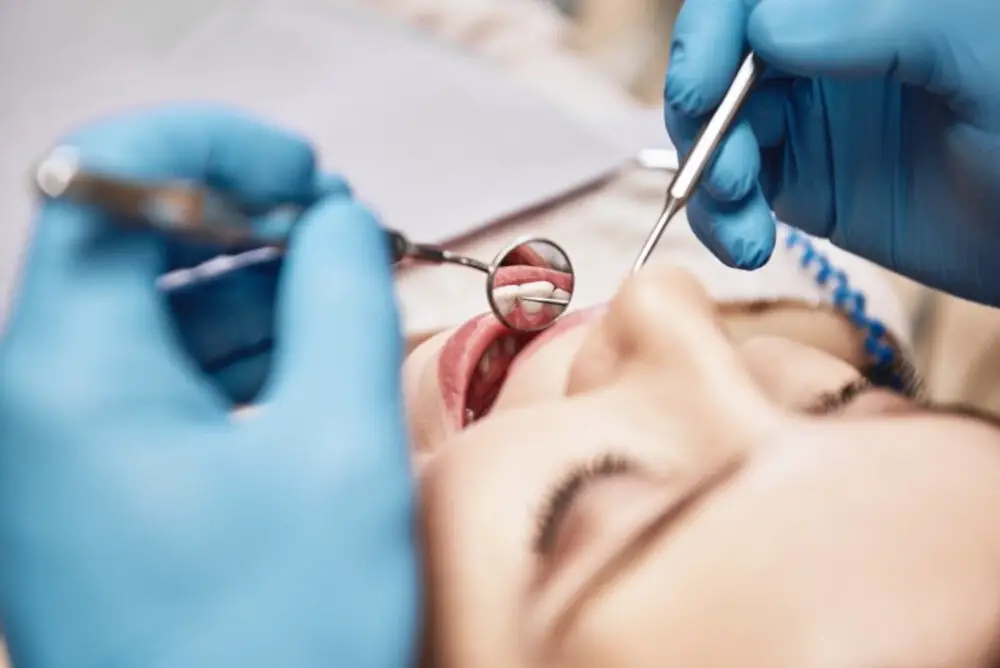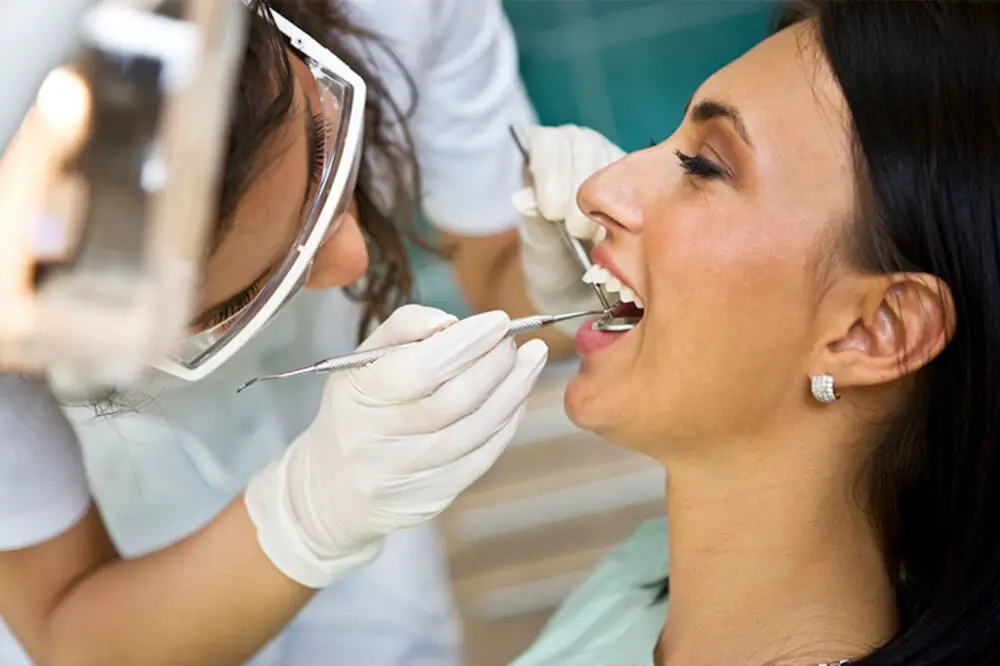Spotting Cavities: A Visual Guide to Recognizing What They Look Like on Teeth

Dental health is a vital aspect of our overall wellbeing. It is not just about having a perfect smile, but it is also about maintaining oral hygiene to prevent various dental diseases. Cavities are one of the most common dental problems that affect people of all ages. They are tiny holes that develop on the surface of teeth due to the accumulation of plaque and bacteria. If left untreated, cavities can lead to severe dental problems, such as tooth decay, gum disease, and even tooth loss. Recognizing cavities is crucial to prevent further damage and seek timely treatment. Often, cavities do not show any symptoms in the early stages, making it challenging to identify them. This visual guide will help you understand what cavities look like on teeth, making it easier for you to spot them and take the necessary steps to maintain your dental health. Whether you are a dental professional or an individual concerned about your dental health, this guide will provide valuable insights to help you recognize cavities and take appropriate action.
Cavities, also known as dental caries, are a common dental problem that occurs due to the formation of plaque on the teeth. Plaque is a sticky film of bacteria that forms on the teeth and produces acid, which can erode the tooth enamel. When the enamel is weakened, tiny holes or cavities can form on the surface of the tooth. If left untreated, cavities can grow larger and deeper, leading to tooth sensitivity, pain, and even tooth loss. Cavities can be prevented by maintaining good oral hygiene practices such as brushing twice a day, flossing regularly, and visiting the dentist for routine check-ups and cleanings.
Spotting cavities early is crucial for maintaining good oral health. Cavities, also known as tooth decay, are caused by bacteria that produce acid, which erodes the tooth’s enamel. When left untreated, cavities can lead to toothaches, infections, and even tooth loss. Therefore, it’s essential to recognize the early signs of cavities, such as white spots or discoloration on the teeth, sensitivity to hot or cold foods, and bad breath. By spotting cavities early, you can prevent them from progressing and avoid expensive dental treatments. Regular dental check-ups and good oral hygiene practices, such as brushing and flossing, can help detect and prevent cavities before they cause significant damage to your teeth.
Signs and Symptoms of Cavities

Cavities are one of the most common dental problems that people experience. They are caused by the buildup of bacteria in the mouth, which produce acids that can eat away at the enamel of the teeth. If left untreated, cavities can lead to tooth decay, tooth loss, and other serious dental problems. Fortunately, there are several signs and symptoms that can help you recognize when you have a cavity. One of the most obvious signs of a cavity is tooth pain. This pain can be sharp or dull and may be felt when you bite down or chew food. You may also experience sensitivity to hot or cold temperatures, as well as sweet or sour foods. Another symptom of a cavity is visible pits or holes in the teeth. These can be seen by your dentist during a routine exam or by looking in the mirror at your teeth. Other signs of cavities include bad breath, swollen gums, and a bad taste in the mouth. If you experience any of these symptoms, it is important to see your dentist as soon as possible to prevent further damage to your teeth. In addition to these symptoms, there are several risk factors that can increase your chances of developing cavities. These include poor dental hygiene, a diet high in sugar and carbohydrates, dry mouth, and certain medical conditions. If you are at risk for cavities, it is important to take steps to prevent them, such as brushing and flossing regularly, eating a healthy diet, and visiting your dentist for regular checkups and cleanings. By taking these steps, you can help keep your teeth healthy and prevent cavities from developing.
Tooth decay, also known as cavities, is a common dental problem caused by the gradual breakdown of tooth enamel. The process starts when bacteria in the mouth feed on sugars and starches, producing acid that erodes the protective layer of the tooth. Over time, this erosion can lead to cavities that appear as small holes or pits on the surface of the tooth. In the early stages, cavities may not cause any noticeable symptoms, but as they progress, they can cause sensitivity, pain, and even infection. Regular dental check-ups and good oral hygiene practices, such as brushing and flossing, can help prevent tooth decay and ensure early detection and treatment.
Cavities, also known as dental caries, are a common problem among people of all ages. One of the most common symptoms of cavities is toothache, which usually occurs when the cavity reaches the nerve of the tooth. In addition to toothache, people with cavities may also experience sensitivity to hot or cold foods and drinks, as well as sweet or sour flavors. Other symptoms may include visible holes or pits in the teeth, dark spots or discoloration, and bad breath. If left untreated, cavities can lead to more serious dental problems, so it’s important to recognize the symptoms and seek treatment as soon as possible.
Self-examining for cavities is an essential part of maintaining good dental health. To begin, grab a mirror and a bright light to help you get a clear view of your teeth. Start by looking at the surfaces of your teeth for any discoloration or spots that are different from the rest of your teeth. Check around the gum line and any areas where food tends to get stuck. If you notice any pits or holes in your teeth, this could be a sign of tooth decay. Additionally, pay attention to any sensitivity or pain you may experience while eating or drinking. Regular self-examinations can help catch cavities early on and prevent further damage to your teeth. If you notice any signs of tooth decay, it’s important to schedule an appointment with your dentist as soon as possible.
Visual Signs of Cavities

Cavities are a common dental problem that can be prevented with proper oral hygiene. However, if left untreated, cavities can cause pain, infection, and even tooth loss. One of the most important ways to prevent cavities is to recognize them early. There are several visual signs of cavities that you can look out for. One of the most common signs is a dark spot or hole on the tooth. This spot will usually be brown or black in color and may be accompanied by sensitivity or pain when eating or drinking. Other signs include white spots on the teeth, which can indicate early decay or demineralization. If you notice any of these signs, it’s important to see a dentist as soon as possible to prevent further damage to the tooth. Another visual sign of cavities is the presence of pits or fissures on the tooth surface. These are small crevices or cracks in the enamel that can trap bacteria and food particles, leading to decay and cavities. In addition, cavities can also cause visible changes in the texture of the tooth, such as roughness or unevenness. This can be especially noticeable when running your tongue over the tooth surface. If you notice any of these signs, it’s important to practice good oral hygiene by brushing and flossing regularly, and seeing a dentist for regular check-ups and cleanings. By recognizing the visual signs of cavities early, you can prevent further damage and maintain good oral health.
Cavities are a common dental issue that occurs due to the decay of teeth. They appear as small holes or openings on the surface of teeth, caused by a build-up of bacteria and plaque. When we consume sugary or acidic foods, the bacteria in our mouths feed on the remnants, producing acid that attacks the enamel of teeth. Over time, this process weakens the enamel, leading to the formation of cavities. If left untreated, cavities can grow larger and cause pain or even tooth loss. Therefore, it is crucial to maintain good oral hygiene practices, such as brushing and flossing regularly, and visiting the dentist for routine check-ups to spot any potential cavities before they worsen.
Cavities are a common dental problem caused by the accumulation of bacteria and plaque on the teeth. They can occur in various forms, including pits, fissures, and smooth surface cavities. Pits are small depressions in the surface of the teeth that are often found in the molars and premolars. Fissures are narrow grooves on the chewing surface of the teeth that can be difficult to clean. Smooth surface cavities, on the other hand, occur on the flat surfaces of the teeth and can be caused by poor oral hygiene habits. It is important to identify the type of cavity to determine the best treatment option and prevent further damage. Regular dental check-ups and good oral hygiene practices can help to prevent cavities from forming.
Healthy teeth are essential for maintaining good oral hygiene and overall health. They are strong, white, and free of cavities. In contrast, teeth with cavities have visible damage to their enamel, which looks like brown or black spots on the surface. The cavities may also cause sensitivity, pain, and bad breath. Moreover, untreated cavities can lead to more severe dental problems, such as gum disease and tooth loss. Therefore, it is crucial to recognize the signs of cavities early and seek professional dental care to prevent further damage and maintain healthy teeth.
Risk Factors for Cavities

Cavities are a common dental issue that can have a significant impact on a person’s oral health. Although cavities can affect anyone, certain risk factors can increase the likelihood of developing them. One of the most significant risk factors for cavities is poor oral hygiene. When a person does not brush or floss regularly, bacteria can grow in the mouth and form plaque on the teeth. This plaque can then erode the enamel, leading to the formation of cavities. Additionally, consuming sugary or acidic foods and drinks can also contribute to the development of cavities. These substances can weaken the enamel and make it more susceptible to decay. Another risk factor for cavities is genetics. Some people may be more predisposed to developing cavities due to the structure of their teeth or the composition of their saliva. Additionally, certain medical conditions or medications can increase the risk of cavities. For example, individuals with dry mouth may be more prone to cavities because saliva helps to protect the teeth from decay. Similarly, some medications can decrease saliva production, leading to a higher risk of cavities. Overall, it is essential to recognize these risk factors and take steps to mitigate them. Maintaining good oral hygiene, consuming a balanced diet, and visiting the dentist regularly can help to prevent cavities and promote optimal oral health.
Cavities are a common dental problem that can have serious consequences if left untreated. Several factors can increase the risk of developing cavities, including poor oral hygiene, a diet high in sugary and acidic foods, dry mouth, and a lack of fluoride in drinking water. Poor oral hygiene allows bacteria to accumulate on the teeth, which can lead to plaque formation and eventually cavities. A diet high in sugary and acidic foods creates an ideal environment for bacteria to thrive, while dry mouth reduces the production of saliva, which helps to neutralize acid and wash away food particles. Additionally, a lack of fluoride in drinking water can weaken tooth enamel, making it more susceptible to decay. By understanding these risk factors, individuals can take steps to maintain good oral hygiene and make dietary changes to prevent cavities from forming.
Reducing the risk of cavities is an essential part of maintaining good oral health. The best way to prevent cavities is by brushing your teeth twice a day with fluoride toothpaste and flossing daily to remove plaque and food particles from between your teeth. Additionally, limiting sugary and acidic foods and drinks like candy, soda, and fruit juices can help reduce the risk of cavities. It is also important to visit your dentist regularly for cleanings and check-ups to detect and treat any cavities before they become more serious. By following these simple steps, you can keep your teeth healthy and cavity-free for years to come.
Treatment and Prevention of Cavities

Cavities are a common dental problem that can cause discomfort and pain. Fortunately, there are several ways to treat and prevent them. Treatment options vary depending on the severity of the cavity. For minor cavities, your dentist may suggest a filling, while more severe cases may require a root canal or extraction. It is important to address cavities promptly to prevent further damage to the affected tooth and surrounding teeth. Preventing cavities is key to maintaining good oral health. Regular brushing and flossing can help remove plaque and prevent the buildup of harmful bacteria that can lead to cavities. A healthy diet that is low in sugar and high in calcium can also help prevent cavities. Regular dental checkups and cleanings can catch cavities early and prevent them from becoming more serious. Your dentist may also recommend fluoride treatments or dental sealants to help strengthen your teeth and protect them from decay. By taking steps to prevent cavities, you can maintain a healthy, beautiful smile for years to come.
Cavities are a common dental problem that requires treatment to prevent further damage to the tooth. One of the most common treatments for cavities is dental fillings. During this procedure, the dentist will remove the decayed portion of the tooth and fill it with a material such as composite resin or amalgam. The filling will restore the tooth’s structure and prevent the cavity from spreading. In some cases, a crown may be necessary to cover the entire tooth if the cavity is too large. Additionally, if the cavity has reached the pulp of the tooth, a root canal may be necessary to remove the infected tissue and save the tooth. It is important to address cavities promptly to prevent further damage and maintain good oral health.
Preventing cavities is essential to maintaining good oral health. Regular brushing and flossing are two crucial components of cavity prevention. Brushing twice a day with a fluoride toothpaste can help remove plaque and food particles from teeth. Flossing once a day can remove plaque and food particles from hard-to-reach places between teeth and under the gum line. Additionally, reducing the intake of sugary drinks and snacks can also help prevent cavities. Eating a healthy diet that is rich in fruits, vegetables, and whole grains can also promote good oral health. Regular dental check-ups and cleanings can also help detect and prevent cavities before they become more serious. By following these tips, you can help maintain healthy teeth and gums for years to come.
Regular dental checkups are crucial in maintaining healthy teeth and gums. These appointments allow dentists to identify any potential problems before they develop into more serious issues. Cavities, for example, can be caught early on during a dental checkup, allowing for prompt treatment and preventing further decay. Additionally, regular checkups include thorough teeth cleanings, which help remove plaque and tartar buildup that can lead to cavities and gum disease. Overall, investing in regular dental checkups is an investment in your oral health and can save you from costly and painful procedures in the future.
Spotting cavities early is crucial to maintaining good oral health. Cavities are caused by decay, which eats away at the enamel of the tooth. If left untreated, cavities can grow larger and cause more damage to the tooth. This can lead to infection, pain, and even tooth loss. By recognizing the signs of cavities early, such as discoloration or small holes in the tooth, you can seek treatment before the cavity gets worse. This can save you from more extensive and costly dental procedures down the line. Additionally, maintaining good oral hygiene habits like brushing and flossing regularly and getting regular dental checkups can help prevent cavities from forming in the first place. By taking care of your teeth and catching cavities early, you can ensure a healthy and happy smile for years to come.
Maintaining good oral hygiene and visiting the dentist regularly is crucial for your dental health. Brushing and flossing twice a day can help prevent cavities from forming, but sometimes they can still occur. That’s why it’s important to make regular visits to the dentist for cleanings and checkups. Don’t wait until you have a toothache or a visible cavity to see the dentist. By then, it may be too late to prevent further damage. The dentist can catch cavities early and provide treatment before they become more serious. By taking care of your teeth and visiting the dentist regularly, you can prevent cavities and keep your smile healthy and beautiful.
Conclusion

In conclusion, being able to recognize the signs and symptoms of cavities is vital for maintaining good oral health. A visual guide can help individuals identify cavities at an early stage, allowing for prompt treatment and preventing further damage to the tooth. It is important to remember that cavities can develop in anyone, regardless of age or oral hygiene practices. Regular dental check-ups and good oral hygiene habits can help prevent cavities from forming in the first place. By being aware of the signs of cavities and taking appropriate action, individuals can ensure that their teeth stay healthy and strong for years to come.






